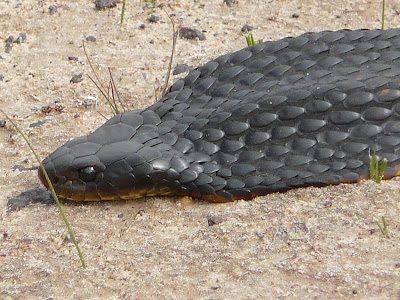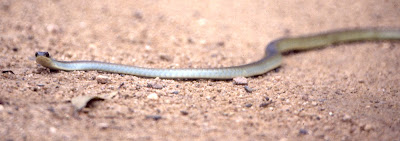We have long known that Australia is fundamentally different from the rest of the world with regard to its mammal fauna and its flora. More recently we've accepted that the majority of our Passerine bird fauna is also uniquely Australian. However an aspect of our biota that is not often discussed in this regard is that the composition of our venomous snake fauna is entirely different from the rest of the world. As ever, we can explain it by seeking to understand the bigger picture.
Some background to snake evolution first. The oldest snake fossils appear to be some 120 million years old, from Algeria. The question has been vigorously debated, but the weight of evidence seems to be swinging towards a burrowing lizard as the ancestor. Snake bones are small and fragile, so the fossil record is not as strong for snakes as it is for most other vertebrate groups, but for some 80 million years python-like or boid-like animals dominated the snake world. Then, around 35 million years ago a group of smaller, quicker snakes arose, though played only a minor role until the world began to cool about 20 million years ago, a situation which didn't suit the boids. From then these Colubrids began to dominate, until now they comprise some two thirds all the world's snakes, over 1900 species. Indeed in much of the English-speaking world they are referred to as 'typical snakes' - not in Australia though. Along the way (perhaps 15 million years ago) they developed large rear teeth which had grooves down the outer edges, along which ran modified saliva that acted as pacifying venom on prey which objected to being eaten.
| Unidentified colubrid, Manu National Park, Peruvian Amazonia. This fellow was encountered on a river beach at night. Any identification help gratefully received! |
 |
| Tree Snake, Limbe Botanic Gardens, Cameroon. I think this one is Thrasops batesii, but again advice welcomed. |
Not long after the venomous back-fanged Colubrids arose, a new group also appeared on the scene. In this group the venomous fangs moved to the front of the jaw, reduced in length and closed around the venom-delivering grooves, to form hollow hypodermic syringes. These Elapids were the ancestors of most of the most venomous living snakes; cobras, mambas, coral snakes, sea snakes - and most of the familiar Australian species, such as brown snakes, taipans, copperheads and black snakes, among which are the world's most venomous species. However, there are only about 320 species, roughly 10% of the world's snakes.
 |
| Tiger Snake Notechis scutatus, Twin Creek Reserve, Western Australia. |
The situation in Australia is dramatically different from the rest of the world. Here, the 120 Elapids represent two thirds of the snake world, while there are only 10 Colubrids, the best known of which are the Brown and Green Tree Snakes.
 |
| Green Tree Snake Dendrelaphis punctulatus, Iron Range, north Queensland. |
The answer to this apparent conundrum is basically down to chance. Both groups arose in the Northern Hemisphere while Australia was isolated; it was the Elapids which made their way here when Australia got close enough to Asia, and in a continent empty of competition they spread to an extent that hadn't been possible elsewhere. By the time Colubrids made the journey, most of the good niches were gone.
The most recent group of snakes to arise, the Vipers, appeared about 10 million years ago. They have very long front fangs, to inject their venom deep into prey. Indeed, the fangs are so long that they must rotate back, to fold away along the roof of the mouth. They haven't yet found their way to Australia.
 |
| forest viper, Bokassa Mountains, Cameroon. Again, I'm afraid I can't provide identification. |
So, Australia, the land of marsupials, of banksias, of honeyeaters - and elapids.